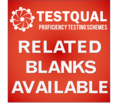Proficiency Tests
Accreditation and Standards
Standards used to design this proficiency test :
- Proficiency test Not accredited, but based in UNE-EN ISO/IEC 17043:2023 General requirements for proficiency testing. Check our accreditation scope..
- UNE-EN ISO/IEC 15328:2015 Statistical methods for use in proficiency test ing by interlaboratory comparison
- HARMONIZED PROTOCOL FOR THE PROFICIENCY TESTING OF (CHEMICAL) ANALYTICAL LABORATORIES
Why TestQual proficiency test ?
| Now you can receive your evaluation within days after the deadline to submit results. New reporting implemented! |
- 20 years of experience in proficiency test s since TestQual's foundation.
- Customized reports: Global report, individual reports, and option for reports by analyte groups.
- Fortification and quality controls available for participants upon request.
- Distributor network: Conveniently place orders in your local language and without worrying about time differences. participation confidentiality is not compromised.
- We take care of everything so you can focus on the analysis.
- Customer service and quick support on all our channels (email, phone, web).
- Innovation and cost-effectiveness: Constant negotiation of shipping costs and materials to ensure your samples arrive in perfect condition and for the best price.
| Our proficiecny test provide you a great way to demonstrate the quality of your analysis and it will contribute to the continuous improvement. We aim to meet your needs and exceed your expectations. |
Proficiency test Information
This proficiency test will consist of a single round, in which a sample will be distributed on the specified date (see calendar). Detailed information about this Proficiency test can be found in the protocol (Calendar, sample quantity, analytes, concentrations, deviation/deviations from target standard). The protocol can be downloaded from the right column of this page.
Intercomparison Calendar
Check the right column of this page, in the "Dates" section.
*These dates are indicative and should always be verified with the dates in the Proficiency test protocol and with the news on the TestQual homepage.
Only registered participants in this proficiency test will receive emails with instructions and confirmation of the definitive distribution date.
Analytes
| Dithiocarbamates expressed as CS2 |
Dithiocarbamates
Dithiocarbamates are compounds analogous to carbamates, but with a sulfur molecule instead of oxygen. There are two types: monoalkyl dithiocarbamates and dialkyl dithiocarbamates (d1). They are organosulfur pesticides used mainly as fungicides and, in some cases, as repellents for mammals. They are non-systemic pesticides, with residues mainly on the crop surface where they have been sprayed (d3), (d4). Dithiocarbamates include maneb, mancozeb, metiram, propineb, tiram, and ziram. Some dithiocarbamates show a certain degree of toxicity to mammals, marine invertebrates, fish, earthworms, and birds, depending on the specific dithiocarbamate being discussed (d3). The main metabolites are ethylenethiourea (ETU) and propylenethiourea (PTU), which have been reported as possible carcinogens for rats (d5) and inhibitors of the thyroid hormone, which can also cause blood and liver problems (d6), among other potential pathogenic effects (d4). Long-term exposure to dithiocarbamates can cause thyroid problems in mammals since their metabolites can inhibit the thyroid hormone. The degree of toxicity varies among different dithiocarbamates (d7). The current definition for these pesticides and reporting results is "Dithiocarbamates, expressed as CS2, including maneb, mancozeb, metiram, propineb, tiram, and ziram" (d8). Some of the difficulties that may arise in the analysis of dithiocarbamates include their low solubility in common solvents for multiresidue extractions and their low stability. The analysis of dithiocarbamates may not be included in a multiresidue analysis (d2). In addition to this, there is a possibility of losses during homogenization at room temperature, and it has also been reported that the use of synthetic plastics, such as gloves, can cause contamination, leading to false positives or higher-than-reality results (d9).
Why participate in a proficiency test program?
Participating in TestQual's proficiency test programs can help you maintain the utmost confidence in your results. The ability of laboratories to analyze and obtain reliable results is crucial for public health. TestQual's proficiency tests provide an opportunity to compare your analysis results with participants from all around the world, allowing you to evaluate your results over time and detect any deviations for prompt correction (specially now that we offer fast evaluation). While a single participation may reveal potential errors, the true value of TestQual's proficiency tests lies in regular and continuous participation, along with each laboratory's internal quality controls, ensuring proper control of the proposed parameters' analysis.
How to register for participation
Laboratories that wish to participate and are not yet registered on our website can do it completing the
REGISTRATION FORM.
If your laboratory is already registered on our website, you can request the participation in this proficiency test by clicking the "Participate" button located both at the top right and bottom of this page. After loggin in, in the PARTICIPATION REQUEST, you must submit your quantification limits of the analytes your laboratory studies. This information is reviewed to ensure the participation will be useful to your laboratory.
Analytes marked as "Not analyzed" (NA) will not appear later, when submitting your data in the results' form. We want to help you focus on the analysis and save you time while giving the best service: you can contact our team and they will give you different options to allow the inscription to this proficiency test, saving time and still ensuring the participation will be useful.
Once the registration is submitted, you will receive an email with your laboratory code for participation in this Proficiency test as soon as possible. Limits of Quantification are requested to ensure that the proficiency test will be useful for you, and in case of any doubts, we would contact you, so you can make an informed decision about your participation. Our aim is to help you showcase your quality.
| Receiving the TestQual laboratory code is synonymous with useful participation in proficiency testing. |
Contact
If you would like a quote or if we can assist you in any way, you can contact us through:
| testqual@testqual.com | |
| Office Phone | (+34) 868-94-94-86 |
| Mobile Phone | (+34) 676-367-555 |
Thank you very much for your interest/trust in TestQual and our proficiency test programs.






